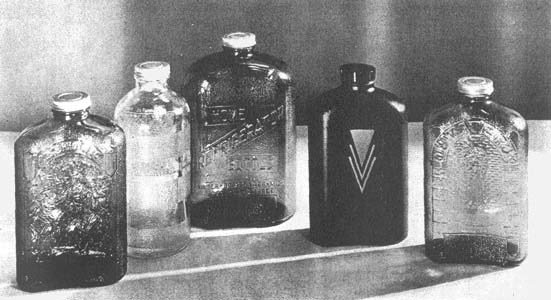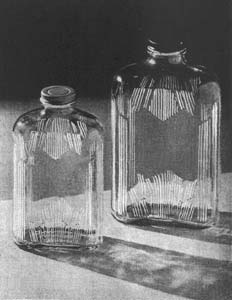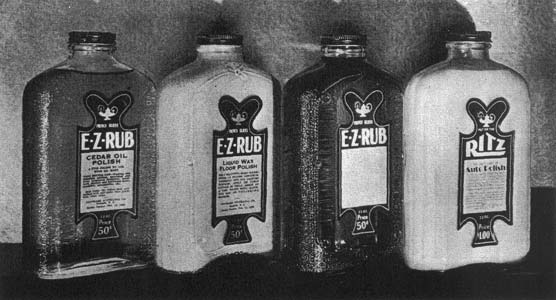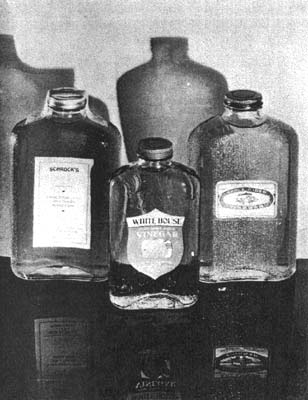[Trade Journal]
Publication: Glass Packer
New York, NY, United States
vol. 11, no. 5, p. 304-305, col. 1-2
 |
Usually sold empty, these should make popular packages
The Refrigerator Bottle
is a "re-useful" container
Packers of many products find it
an answer to their sales problem
THERE has been a great deal of talk about re-usable containers. Some of it is pro, some con, but most is theoretical. Perhaps it would be a good idea to set down to cases. Take the refrigerator bottle, today probably the best known re-use container of them all.
Unlike some containers in its category, the refrigerator bottle does not seem to be merely a novelty or "stunt" package — used for a short time and then abandoned in favor of something newer or more sensational. As a matter of fact, it seems to be gaining favor as a standard type which packers of a wide variety of products find an answer to the container problems. Such users do not appear to regard this bottle as a "premium," for the sake of which the customer may be willing to purchase the contents. On the contrary, most of the concerns employing the refrigerator flask for packing seem to be doing so primarily on account of its very real advantages as a package.
It is good looking. One glance is sufficient evidence of that.
It is convenient to handle. The flat shape and corrugated sides make it fit the grasp much more securely than a round bottle of similar capacity. (1)
 |
Designed for packing — AND for re-use purposes
It is economical of shelf and shipping space, perhaps being as efficient in this regard as any container on the market.
It is well balanced and rests quite securely wherever it is placed.
The above characteristics, while all-important from a packaging standpoint, also have a vital bearing on the secondary use for these unique containers, which, as the name "refrigerator bottle" indicates, is as a storage container for any liquid kept in the refrigerator or "ice-box. How well this bottle will serve that particular purpose is immediately evident to anyone who is familiar with the amount of space available in the ice chamber or along side of the coils of the electric refrigerator.
 |
The refrigerator bottle performs an unusual service for these polishes
Although its character as a package has been emphasized, it is not intended that the importance of the secondary use for the refrigerator bottle should in any way be minimized. Hundreds of thousands of these bottles have been sold empty in the ten-cent stores, and of the several glass companies making them (2) at least one has distributed a large part of its output through this and similar channels. This particular company has an extensive line of water flasks in elaborate molds, featuring such subjects as "George Washington," "Spirit of '76," "The Old Oaken Bucket," and so on. Hand decorated bottles with Christmas, Thanksgiving and other holiday designs are also made, as are plain bottles with blown in labels stating that they are for iced-tea, milk, coffee, water or other beverages. Many of these bottles could be used for packing purposes.
Since people are willing to pay money for empty refrigerator bottles it is not surprising that their use as packages has greatly increased sales of certain products. This has not been true in every case, but most users are very enthusiastic about the results gained, which frequently have been "beyond all expectations." As a rule the refrigerator bottle is employed as a container for food products like tomato juice, tomato juice cocktail, vinegar, cider and syrups. However, it also makes an attractive package for bath salts, mineral oil, rubbing alcohol or ammonia, while one manufacturer is using it for a line of auto and furniture polishes, floor-wax, etc., with great success!
 |
Attractive containers for maple syrup and vinegar.
(1) The refrigerator bottle is being made in standard capacities of one pint, 24-oz., one quart and one-half gallon, finished for continuous thread closures.
(2) Companies manufacturing refrigerator bottles: Hemingray Glass Co., Muncie, Ind.; Tygart Valley Glass Co., Washington, Pa.; Owens-Illinois Glass Co., Toledo, Ohio; Fairmount Glass Works, Inc., Indianapolis, Ind.; General Glass Corporation, Lancaster, Ohio.
